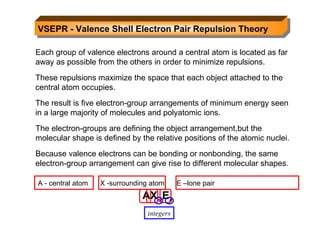VSEPR theory describes the electron-group arrangements and molecular shapes that result from electron-pair repulsions around a central atom. The theory states that valence electron groups will adopt an arrangement that minimizes repulsions between these groups. This results in five basic molecular geometries - linear, trigonal planar, tetrahedral, trigonal bipyramidal, and octahedral. Factors such as double bonds, lone pairs, and differing atomic sizes can cause deviations from ideal bond angles predicted by VSEPR theory.















































